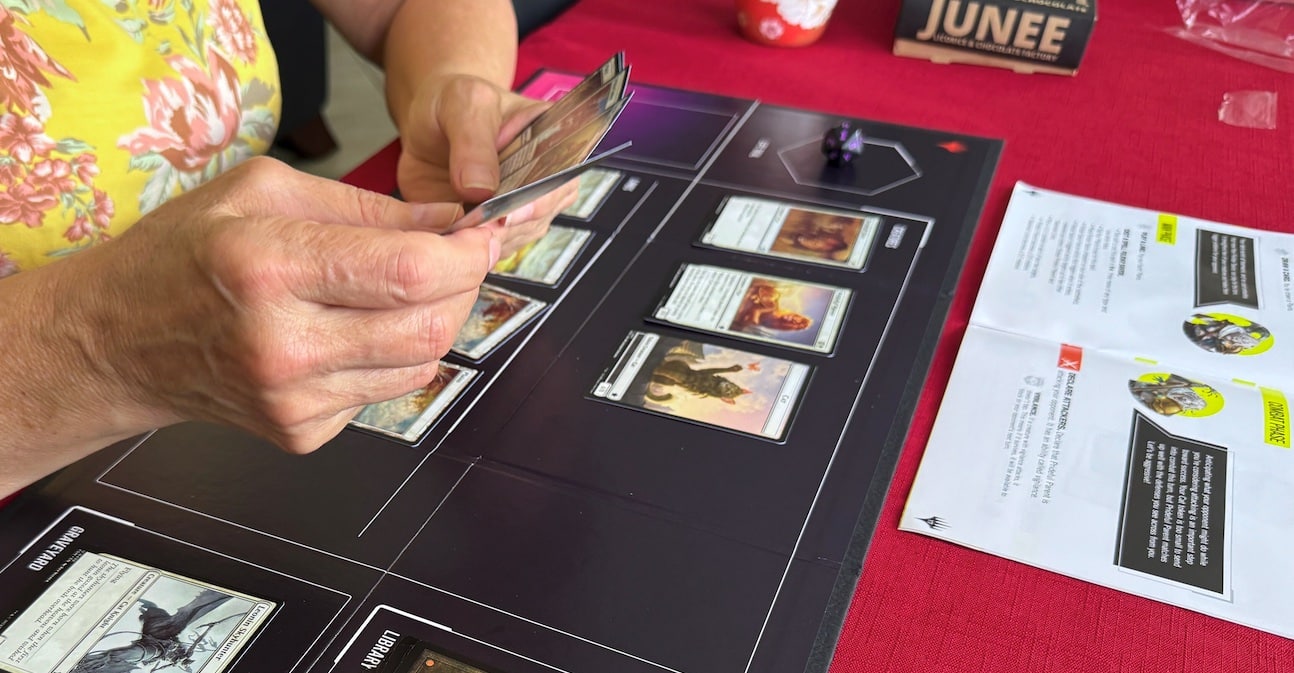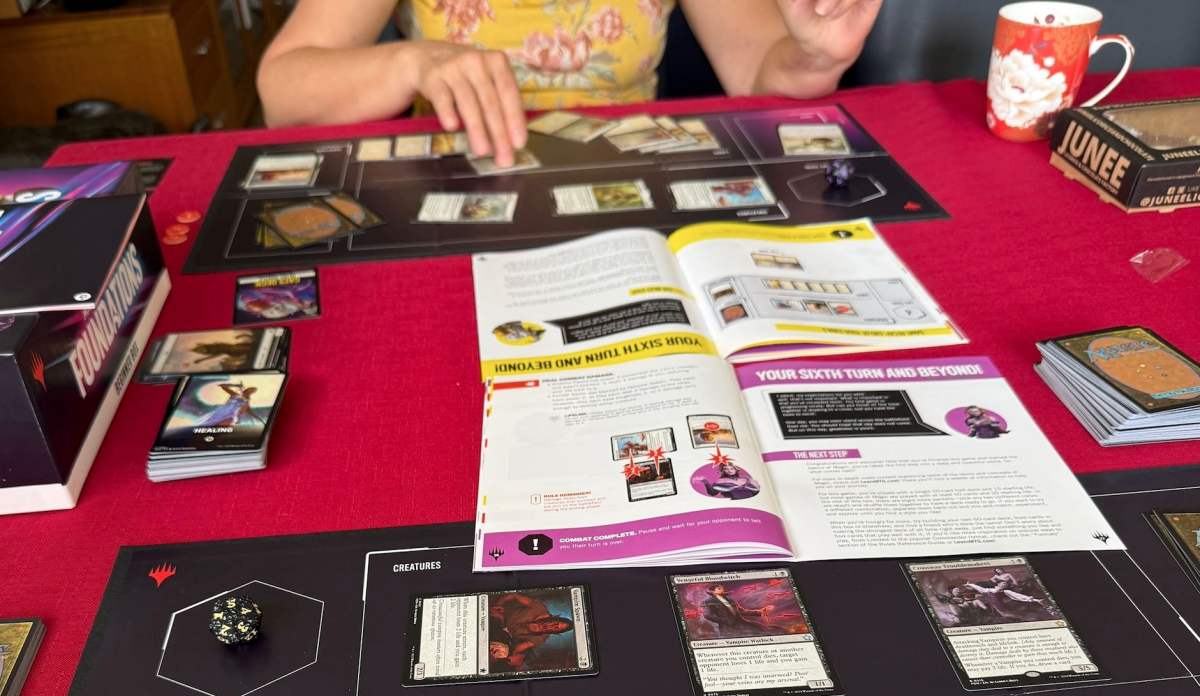Magic: The Gathering‘s newly-released Foundations set was designed as a perfect introduction for players new to the long-running game. With decades of sets, rules, card types, and intricacies to learn, the idea of getting into MTG “late” is incredibly daunting – but the set aims to clear hurdles with a range of neat inclusions, including a Beginner Box with a step-by-step guide to learning gameplay.
Folks, if you’ve got a passion for MTG and you’re keen to share it with those less familiar, the Beginner Box is spectacular. I sat down with my mum to teach her about the game, and not half an hour later, she was whittling away at my health with a pack of lions – to my great pride and joy.
Since getting properly into MTG in early 2024, I’ve tried explaining to my mum why it’s great. Sharing your joy and excitement is what life’s all about, after all. But without a tangible means to walk through the game, it was reduced to cardboard with pretty pictures.
With the launch of Foundations‘ Beginner Box, I finally had means to share my passion, even with the barrier of my mum being somewhere on the “neutral to hater” spectrum when it comes to card and board games.
Read: MTG: Duskmourn set review – Enter a new world of pain
What works so well about the Beginner Box is that it’s incredibly structured and hand-holdy. For newer players, you absolutely need this. It’s easy to forget how complex MTG can be, particularly for those who aren’t that familiar with card games at all. (At the very least, I had recently schooled my mum on Disney Lorcana, so she knew the basics of playing “power” to play cards.)

In the box, you’ll find a playing board with spaces for your deck, graveyard, exile, and so on, as well as a range of jumpstart decks, two dice, and three instruction booklets. One is a general rules booklet, which can be useful for explaining the basics of gameplay and getting started – but what you’ll want to begin with is the dual Vampire and Cats guides, which are designed for immediate two-player kick-off.
One player takes the Vampires guide and the respective Vampire mini-deck, and the other player takes the Cats guide, and the respective Cats mini-deck. In my particular game, I was Vampires, and my mum was Cats. I gave her a relatively basic verbal rundown of gameplay (These are lands, here’s what they do. These are character or “spell” cards, and you must place lands to play these cards.) and then we were off to the races.
In each guide, you get a detailed breakdown of turns and turn order, with explanations for each happenstance. The game is essentially being played for you, which some players may not like, but I found the breakdowns perfect for easing the burden of explanation, while providing solid context for my mum to learn as she went.
The instructions are basically “Play this land. Here’s why you played this land, and what you should do this turn. Here’s why you’re doing it.” For the first five turns, everything is clearly dictated, with each card placement also introducing a new keyword. Flying comes into play. Then First Strike, and Deathtouch and Lifelink, and Vigiliance, and so on. There are many, many keywords not covered – but the primary ones appear in these basic decks, to start the learning journey. All the cards also explain the keywords, which is a nice touch to remind new players of what they do.
After five turns of exact instructions, with the guides dictating exactly which moves to perform, and with that all-important context, players are set free. While this worried me at first, my mum took off after this instruction, five rounds being enough to give her the basic framework of turns. Without my prompting, she drew a card, placed a land, then played a lion hero, and decided to attack.
There was some teething with explaining why she shouldn’t attack with a 3/3 creature while I had a 3/4 blocker available, and why a 1/1 Cat should block a 5/5 attack – but mostly, she knew what she was doing, and it was great to see her picking up the game so quickly.

That’s the magic of the Beginner Box. Even with zero experience, and quite frankly, zero interest, my mum was able to understand turn order, card placement, tapping lands to play cards, the nature of power on the battlefield, how to attack, and when to block. Sometimes, you need a good hand hold, and that’s what the dual guides of this box do – they provide essential context for gameplay, with a neat commentary that allows you to properly understand decisions and game flow.
You’re not simply placing cards and shrugging. You’re learning the why, which is far more important.
Set free, I did end up destroying my mum’s creatures and her health, but she gave me a fair run on the way, playing strong cards and biding time for attacks, with the basics in-hand. I can’t say I’ve made a believer of her – not for lack of trying – but she now understands a lot more about one of my most-consuming hobbies. I can imagine that those who are passionate about learning the game will find an ample introduction in this Foundations Beginner Box, and a jumping-off point for further learning.
Beyond the two “main” decks, which are great and well-balanced, there’s also a number of other jumpstart decks included for perusal, each introducing new character types and mechanics, and providing ample scope for longer-term enjoyment. You can also mix and match these decks, and use them to play different MTG formats in perpetuity.
PASSWORD: Beginner
More people playing Magic: The Gathering is always a good thing – and it’s great to see this Beginner Box launching as a means to introduce more folks to the game. With strong design and simple setup, this could be the gateway to enthralling your friends, or to get started with the game yourself.
There’s big plans for MTG in 2025 – including major crossovers with Final Fantasy and the world of Marvel, so the Beginner Box arrives at the perfect time for any curious newbies. If you’re looking for an entry point to MTG, this is it.
Magic: The Gathering – Foundations Play Boosters, Collector Boosters, and the Beginner Box were provided to GamesHub for the purposes of this review. GamesHub has affiliate partnerships. These do not influence editorial content. GamesHub may earn a small percentage of commission for products purchased via affiliate links.





